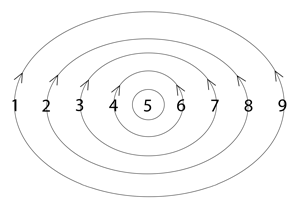form
6-1-7
Conventional Understanding
We typically think of “form” as the shape or structure things have – a static property we observe rather than participate in creating. When something “takes form,” we imagine it reaching a final state, like clay hardening into a fixed shape. This view positions us as passive observers of independent objects, missing how form emerges through the active pattern of our attention. Our education systems reinforce this by teaching us to memorize the “facts” about reality rather than engaging with how it takes shape.
Resonant Understanding
Word Cosmology shows “form” (6-1-7) shares its resonance pattern with “expressed” and “visible,” revealing it as the point where potential becomes perceptible. Like a sculptor who doesn’t create marble but reveals what’s already there by directing attention, form is where the invisible becomes visible. Think of clouds forming – they don’t appear from nowhere but emerge as water vapor condenses into visible patterns. Form isn’t a fixed structure but the dynamic pattern where potential becomes perceivable through focused attention.
Expressions – Spectrum Analysis
In balanced expression, form appears as “consciously experience” and “emergence” – the natural unfolding of potential through aware participation. “Essence” shows balanced form revealing inherent nature rather than imposed structure. “Integrating” reflects organizing energy without forcing it.
When over-modulated, we see “controlled imbalance” and “cage” – excessive structure restricting natural flow. “I create the rules” and “I impose my reality” show forcing rather than allowing natural emergence. This rigidity appears when form becomes about establishing fixed positions.
Under-modulated expressions include “absent” and “block” – insufficient attention creating incoherent manifestation. “Calcified” and “false” show patterns appearing when manifestation lacks conscious participation. “I am tired” reflects disconnection from the forming process.
Beyond these patterns, words like “individuated ideas,” “self-creating universe,” and “gyroscopic principle” also share this resonance, reflecting organizing principles related to form.
Russell’s Cosmogony Connection
Walter Russell describes how apparent substance emerges through motion:
“All matter is but pressure-conditioned motion. Varying pressure conditions yield varying states of motion.”
This illuminates how form isn’t solid substance but organized motion that appears substantial. Russell explains:
“If a cobweb could move fast enough, it would simulate a solid steel disc—it would be the motion which cut through steel.”
This shows how form isn’t about creating something from nothing but organizing motion into patterns that appear as substance.
Practical Implications
This transforms our approach to creativity. Rather than “creating something from nothing,” we can recognize form as revealing potential already present through attention patterns. This suggests practices of present awareness and allowing rather than forcing – becoming sensitive to what naturally unfolds.
In education, this shifts from teaching rigid methods to developing sensitivity to emerging patterns. When facing creative blocks, we might adjust our attention – releasing control if over-rigid or engaging more consciously if under-connected, allowing form to emerge through balanced participation with natural unfolding.
Walter Russell’s quotes are from his book, “A New Concept of the Universe”.
Related Words:
No results found.


